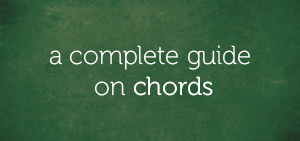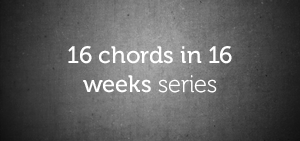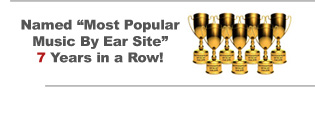In today’s lesson, we’ll be doing a chord quiz that I captioned “what do you see?”
When a chord is played at random, what do you see? Do you just stop at identifying the chord?
Truth be told, recognizing a chord (aka – “chord recognition”) is good, but knowing its function and how it is applied is better. This lesson is basically a quiz that will drill you on the harmonic functions of chords.
If you’re interested in going beyond the recognition of chords to knowing their functions, then this chord quiz is for you.
Chord Quiz – Number One
Given the chord below:
…what do you see?
You can either choose to see just a C major triad:
…or to go beyond seeing a C major triad to seeing
Chord one:
…in the key of C:
Chord four:
…in the key of G:
…and chord five:
…in the key of F:
It’s common for everyone to perceive the given triad as the C major triad:
…however, a musician who is exposed to the harmonic functions of chords goes beyond seeing just a C major triad to seeing other harmonic potentials in the triad.
In the key of C:
…the chord of the first degree (aka – “the tonic triad“) is the C major triad:
In the key of G:
…where the fourth degree is C:
…the chord of the fourth degree is the C major triad:
In the key of F:
…where the fifth degree is C:
…the chord of the fifth degree is the C major triad:
So when this chord is given:
…do you see just a C major triad, or do you go beyond the C major triad to see the following…
- Chord one in the key of C
- Chord four in the key of G
- Chord five in the key of F
Chord Quiz – Number Two
In the chord that is given:
…what do you see?
Do you see a C major seventh chord:
…or do you see chord one:
…in the key of C:
…and chord four:
…in the key of G:
If you see a C major seventh chord:
…that’s cool and I appreciate your chord recognition ability. But beyond chord recognition, it is very important for you to know that this is chord one:
…in the key of C:
…and chord four:
…in the key of G:
In the key of C:
….where C:
…is the first degree of the scale, the C major seventh chord:
…is the seventh chord of the first degree. Also in the key of G:
…where C:
…is the fourth degree, the C major seventh chord:
…is chord four. Do you see a C major seventh chord:
…or do you see chord one:
…in the key of C:
…and chord four:
…in the key of G:
Chord Quiz – Number Three
Can you identify the chord below:
If your answer is the C minor triad, you’re correct – at least you recognized the chord.
However, in the spirit of today’s lesson that says “what do you see?”
There’s need to go beyond the C minor triad:
…to see chord two:
…in the key of Bb:
…chord three:
…in the key of Ab:
…and chord six:
…in the key of Eb:
In the key of Bb:
…the C minor triad:
…is chord two because C:
…is the second degree of the Bb major scale:
In the key of Ab:
….where C:
…is the third tone of the Ab major scale, the C minor triad:
…is chord three.
In the chord given:
…you need to see the following functions…
- Chord two in the key of Bb
- Chord three in the key of Ab
- Chord six in the key of Eb
Chord Quiz – Number Four
In the chord given:
…what do you see?
The chord given, for all intents and purposes is the C minor seventh chord:
However, beyond knowing that this:
…is the C minor seventh chord, you need to also realize that this is chord two:
…in the key of Bb:
It is also chord three:
…in the key of Ab:
…and chord six:
…in the key of Eb:
“Let me show you how the functions of the C minor seventh chord are derived…”
The C minor seventh chord:
…is chord two:
…in the key of Bb:
…because in the key of Bb:
…C:
…is the second degree of the scale.
In the key of Ab:
…C:
…is the third degree of the scale.
This explains why the C minor seventh chord:
…is chord three in the key of Ab:
Finally, in the key of Eb:
…C:
…is the sixth degree of the scale.
So, the C minor seventh chord:
…is chord six in the key of Eb:
Final Words
The ability to recognize chords at sight and name them properly is commendable. For example, recognizing that this:
…is the C major triad, or that this:
…is the C minor triad, is good. However, it’s better to go beyond the recognition of the name of the chord to the knowledge of its function.
I’ll be back with another chord quiz, where we’ll handle other classes of chords.
Thank you for your time!
Chuku Onyemachi
Latest posts by Chuku Onyemachi (see all)
- The Formation Of Diminished Seventh Chords Used To Be Challenging Until I Did This
- How To Form Seventh Chords In Two Shakes Of A Dog’s Tail Using Third Intervals And The Circle Of Fifths Chart
- I Played The 13sus4 Chord And This Happened…
- How To Build Seventh Chords Like An Architect Using “Foundation And Structure” Concept
- This 4-Week Plan Will Help You Master All The Major Scales







Comments on this entry are closed.